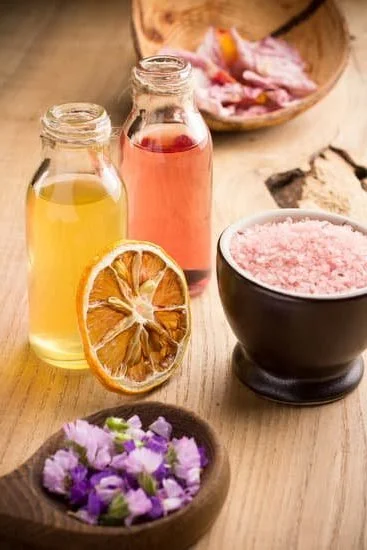Are you wondering, “Can I use aromatherapy oils in candles?” Aromatherapy is the use of natural plant extracts to promote health and well-being, while candles have long been used for relaxation and ambiance. In this article, we will explore the world of aromatherapy and candles, and how you can combine them to create a soothing and therapeutic experience.
Aromatherapy oils can be a great addition to candle making, as they can provide added benefits such as stress relief, mood enhancement, and improved sleep quality. By infusing your candles with essential oils, you can create a calming atmosphere that promotes overall wellness.
When it comes to choosing the right aromatherapy oils for candle making, there are various options available that offer different scents and therapeutic properties. From lavender for relaxation to eucalyptus for respiratory support, each oil has its own unique benefits that can enhance your candle experience. In the next sections, we will delve into the various types of aromatherapy oils suitable for candle making and how to use them effectively.
Benefits of Aromatherapy Oils in Candles
Aromatherapy is the use of essential oils to promote relaxation, reduce stress, and improve overall well-being. When combined with candles, these aromatherapy oils can create a soothing and therapeutic atmosphere in any space. There are several benefits to using aromatherapy oils in candles, making them a popular choice for both personal use and as gifts.
Enhanced Aromatherapeutic Effects
The heat from the candle flame can help to distribute the scent of the essential oils more effectively, filling the room with the calming and rejuvenating aroma. This can enhance the aromatherapeutic effects of the oils, allowing individuals to fully experience their benefits. Whether you’re looking to unwind after a long day or create a tranquil environment for meditation or yoga, using aromatherapy oils in candles can help set the mood and promote relaxation.
Aesthetic Appeal
In addition to their therapeutic benefits, aromatherapy oil-infused candles also add aesthetic appeal to any space. These candles come in various designs and scents, making them versatile decor pieces for different settings such as homes, spas, and offices. Whether you prefer earthy scents like lavender or citrus notes like lemon, there is a wide range of options available for creating personalized ambiance with the visual and olfactory appeal of aromatherapy oil-infused candles.
Personalized Experience
One of the major benefits of using aromatherapy oils in candles is the ability to tailor the experience to individual preferences. With a variety of essential oils available on the market, individuals can customize their candle-making process by choosing specific scents that cater to their unique needs and preferences. Whether it’s promoting focus and clarity with peppermint oil or achieving a sense of calmness with chamomile oil, individuals can personalize their aromatherapy candle experience for maximum benefit.
Overall, incorporating aromatherapy oils into candle making not only enhances their therapeutic effects but also adds an element of personalization and aesthetic charm to any space they grace. By understanding how different essential oil scents can affect mood and well-being, individuals are able to harness the power of these natural remedies through the comforting glow of candles.
Types of Aromatherapy Oils Suitable for Candle Making
When it comes to creating aromatherapy candles, choosing the right essential oils is crucial in ensuring maximum benefits for both the mind and body. There are a wide variety of essential oils available for candle making, each with its own unique properties and benefits. Some of the most popular types of aromatherapy oils suitable for candle making include lavender, eucalyptus, peppermint, and citrus oils such as lemon or orange.
Lavender essential oil is well-known for its calming and relaxing properties, making it a perfect choice for creating candles that promote stress relief and better sleep. Eucalyptus oil is often used in candles to help clear the airways and promote easier breathing, especially during cold and flu season.
Peppermint oil can be invigorating and refreshing, offering a burst of energy and mental clarity when used in candles. Citrus oils like lemon or orange can help uplift mood and create a bright, cheerful atmosphere in any space.
When selecting aromatherapy oils for candle making, it’s important to consider the desired effects and benefits that you want to achieve. Whether you’re looking to relax after a long day or boost your energy levels, there are essential oils that can cater to your specific needs.
Additionally, choosing high-quality essential oils from reputable suppliers ensures that you are getting the most potent and pure oils for your candles. With the right combination of aromatherapy oils, candle making can become a therapeutic and beneficial practice for both the maker and the user.
How to Use Aromatherapy Oils in Candle Making
Aromatherapy oils can be a great addition to your candle making process, adding both fragrance and potential health benefits to your homemade candles. Here are some steps to follow when using aromatherapy oils in candle making:
- Choose the Right Oils: Not all essential oils are suitable for candle making. When selecting aromatherapy oils for your candles, it’s important to choose high-quality, 100% pure essential oils that are safe for use in candles. Look for oils that are specifically labeled as “candle safe” or “safe for use in soy wax.”
- Adding the Oils: Once you’ve selected your aromatherapy oils, it’s time to add them to your candle wax. The general rule of thumb is to use approximately 1 ounce of essential oil per pound of wax. However, it’s important to refer to specific guidelines provided by the oil manufacturer and conduct small test batches to ensure the desired strength of scent.
- Mixing the Oils: To ensure that the aromatherapy oils are evenly distributed throughout the candle, it’s important to thoroughly mix them with the melted wax before pouring the mixture into the container. Stirring gently and consistently will help achieve an even scent throw when burning the candle.
Following these steps will help you effectively incorporate aromatherapy oils into your homemade candles, providing both a pleasant aroma and potential therapeutic benefits when burned.
Additionally, when using aromatherapy oils in candle making, it’s crucial to consider safety precautions such as proper handling and storage of essential oils. Keep in mind that certain essential oils can be flammable and may need specific handling instructions.
Always refer to recommended usage rates and safety data provided by oil manufacturers when incorporating them into your candle making process. With careful consideration and adherence to safety guidelines, you can successfully create beautifully fragrant candles infused with the benefits of aromatherapy oils.
Safety Precautions When Using Aromatherapy Oils in Candles
When using aromatherapy oils in candles, it is essential to take certain safety precautions to ensure a safe and enjoyable experience. Aromatherapy oils are highly concentrated and can pose some risks if not used properly. Here are some safety precautions to keep in mind when using aromatherapy oils in candle making:
- Dilution: Aromatherapy oils are potent and should be properly diluted before being added to the candle wax. Direct application of undiluted essential oils can cause skin irritation and other adverse reactions.
- Ventilation: When melting the wax and adding the aromatherapy oils, ensure that the area is well-ventilated to prevent inhalation of strong fumes. Proper ventilation is crucial for your respiratory health.
- Skin Contact: Direct skin contact with undiluted aromatherapy oils can cause irritation or allergic reactions in some individuals. It’s important to handle these oils with care and avoid contact with the skin as much as possible.
In addition to these precautions, it’s also important to consider the type of essential oils being used in candle making. Some essential oils may not be suitable for use in candles due to their composition or potential reactivity with the wax. Always research and choose appropriate aromatherapy oils for candle making.
Ultimately, while using aromatherapy oils in candles can enhance your overall experience, it’s crucial to prioritize safety at every step of the process.
Remember that when handling any form of potent oil or substance, including essential oils like those used in aromatherapy, proper care should always be taken into consideration”.
Where to Purchase Aromatherapy Oils for Candle Making
When it comes to purchasing aromatherapy oils for candle making, there are a few options to consider. The first and most convenient option is to purchase them from specialty stores that carry a wide range of essential oils specifically designed for aromatherapy and candle making. These stores often have knowledgeable staff who can guide you in selecting the right oils for your candles based on their intended purpose.
Another option is to purchase aromatherapy oils online. There are many reputable websites that specialize in selling high-quality essential oils for various purposes, including candle making. When purchasing online, be sure to read customer reviews and check the quality and purity of the oils before making a purchase. It’s important to ensure that the oils are suitable for use in candles and are safe for inhalation.
Specialty Stores
Online Retailers
DIY Extraction
Some individuals may opt to make their own aromatherapy oils at home using natural ingredients such as herbs, flowers, or citrus peels. This DIY method offers complete control over the ingredients used but requires thorough research on proper extraction methods and safety precautions.
DIY Aromatherapy Candle Recipes
Aromatherapy candles can be a wonderful addition to any home, providing both a pleasant fragrance and potential therapeutic benefits. Making your own aromatherapy candles is a fun and creative way to personalize the scents to suit your preferences. Here are some simple and easy DIY aromatherapy candle recipes that you can try at home.
One of the simplest DIY aromatherapy candle recipes involves using soy wax and essential oils. Start by melting the soy wax in a double boiler, then add your chosen essential oils once the wax has reached the desired temperature. Popular essential oils for relaxation include lavender, chamomile, and sandalwood, while invigorating scents can be created using citrus oils like lemon or orange.
Another option is to create layered aromatherapy candles using different essential oil blends for each layer. For example, you could use a calming blend of lavender and frankincense for the bottom layer, followed by a refreshing blend of eucalyptus and peppermint for the middle layer, and finally a grounding blend of cedarwood and patchouli for the top layer. This not only looks visually appealing but also allows you to enjoy multiple scent combinations in one candle.
You can also add dried herbs or flowers to your aromatherapy candles for an added visual element and an extra burst of natural fragrance when the candle is lit. For example, adding dried rose petals to a candle infused with rose essential oil can enhance both the look and scent of the finished product.
Be sure to experiment with different combinations until you find the perfect mix that suits your preferences. These DIY aromatherapy candle recipes allow you to customize the fragrances in line with your personal tastes while harnessing the potential therapeutic properties of essential oils.
Conclusion
In conclusion, using aromatherapy oils in candles can be a wonderful way to enhance the ambiance of your space while also reaping the benefits of essential oils. Aromatherapy has been known to promote relaxation, reduce stress, and even improve mental clarity, making it a valuable addition to any candle-making project. The scent of the chosen essential oil can have a powerful impact on mood and emotions, so selecting the right one is important for achieving the desired therapeutic effect.
When choosing aromatherapy oils for candle making, it’s essential to select high-quality oils from reputable sources. Whether you prefer floral, citrus, or earthy scents, there are numerous options available to suit your personal preferences and wellness needs. Additionally, experimenting with different combinations of essential oils can create unique and personalized blends that cater to specific moods or intentions.
It’s important to keep in mind that safety precautions should always be taken when using aromatherapy oils in candles. This includes closely following candle-making instructions and guidelines for diluting essential oils properly.
By practicing safe usage methods and being mindful of potential risks associated with essential oils, you can enjoy the benefits of aromatherapy in candle form without compromising safety. Overall, integrating aromatherapy oils into candle making can elevate your self-care routine and bring a sense of tranquility and well-being into your daily life.
Frequently Asked Questions
Is It Better to Use Essential Oils or Fragrance Oils for Candles?
The choice between using essential oils or fragrance oils for candles ultimately depends on personal preference. Essential oils are natural and offer therapeutic benefits, while fragrance oils come in a wider variety of scents.
Can You Put Any Fragrance Oil in Candles?
Not all fragrance oils are suitable for use in candles. It’s important to use fragrance oils specifically designed for candle making to ensure the best scent throw and burning performance.
Are Fragrance Oils Safe to Burn in Candles?
Fragrance oils are generally safe to burn in candles when used according to the manufacturer’s guidelines. However, it’s essential to use high-quality, safe fragrance oils that are specifically formulated for candle making to minimize any potential risks.

Are you looking for a natural way to improve your health and wellbeing?
If so, aromatherapy may be the answer for you.





